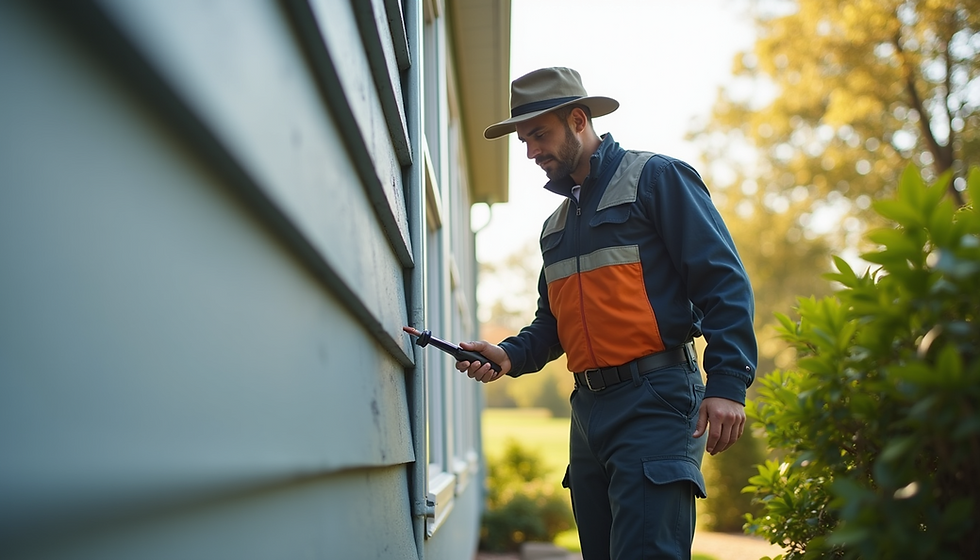What to Do When You Find a Wasp Nest
- Shahid AR
- Jul 1
- 3 min read
Finding a wasp nest in or around your home can be alarming. Wasps can be aggressive, especially if they feel their nest is threatened. Knowing how to react is essential for your safety and well-being. This article provides practical steps to take when you discover a wasp nest, helping you manage the situation effectively.
Understanding Wasp Nests
Wasp nests can vary in size and structure, but they are typically made from chewed wood fibres mixed with saliva, forming a paper-like material. These nests can be found in trees, bushes, under eaves, or inside structures. The two most common types of wasps that build nests are yellow jackets and paper wasps.
While yellow jackets tend to build their nests underground or in hidden areas, paper wasps prefer to construct their nests in exposed locations. It's important to identify which type of wasp you are dealing with, as their behaviour and level of aggression can differ.

Spotting a Wasp Nest
Keep an eye out for wasps flying in and out of a particular location. If you notice a steady stream of wasps, you may have located a nest. Mark the area and keep a safe distance to avoid provoking the insects.
Safety Precautions When You Find a Wasp Nest
Your safety is the top priority when dealing with a wasp nest. Here are some critical precautions to consider:
Stay Calm: First and foremost, keep your cool. Wasps can sense panic and may become aggressive.
Don’t Disturb the Nest: Avoid trying to swat or disturb the wasps. They will defend their nest aggressively if threatened.
Create a Safe Perimeter: If you have children or pets, ensure they stay away from the nest until it is dealt with adequately.

Wear Protective Clothing: If you do need to handle the situation, wear long sleeves, pants, gloves, and a hat to protect your skin from stings.
How to Remove a Wasp Nest
Removing a wasp nest should be approached with caution. You have a few options:
DIY Removal
If the nest is small and accessible, you may consider attempting removal yourself. Here are the steps to follow:
Choose the Right Time: Early morning or late evening is the best time to remove a nest, as wasps are less active during these hours.
Use the Right Equipment: A wasp spray from a distance can be effective. Make sure it is specifically designed for wasp removal, as it will allow you to spray from a safe distance.
Approach with Care: Stand at least 10 feet away and aim the spray directly into the entrance of the nest.
Hiring Professionals
If the nest is large or difficult to reach, hiring a specialist is advisable. Removing wasp nests can be dangerous, and professionals have the tools and skills necessary for safe removal. Look for a service that offers professional wasp nest removal.

How much does it cost to remove a wasp nest?
The cost of wasp nest removal can vary significantly based on several factors, including:
Type of Nest: The size and location of the nest play a big role in determining the cost. Larger nests or those in hard-to-reach areas may be more expensive to remove.
Location: Prices can differ by region and may be higher in urban areas or regions with high demand for pest control services.
Time of Year: Costs may fluctuate according to the season, with higher prices typically seen in late summer when wasps are most active.
On average, homeowners might expect to pay between £100 to £300 for wasp nest removal.
After the Nest Is Removed
Once you've successfully removed the nest, there are a few additional steps you can take to prevent wasps from returning:
Seal Entry Points: Check your property for holes or gaps where wasps might be able to establish a new nest. Use caulk or other sealing methods to close these areas.
Remove Food Sources: Eliminate potential food sources that can attract wasps. Keep trash cans closed and clean up any food scraps or spills.
Use Repellents: Consider using wasp-repellent sprays or traps around your home to discourage future nesting attempts.

Final Thoughts
Finding a wasp nest can be a stressful experience, but with the right information and precautions, it is manageable. Whether you choose to tackle the situation yourself or hire professionals, understanding the behaviour of wasps and staying safe is paramount. Always remember that when in doubt, seeking help from experts ensures your safety and effectively resolves the issue.






Comments